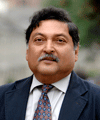September
The sky's the limit for schools in the cloud

TED Prize winner Professor Sugata Mitra, who challenges how we teach children in a technological age, has been sharing his vision for the future of education at the British Science Festival in Newcastle.
‘Schools in the Cloud’, which have just begun to take shape in India, are the culmination of over a decade of research and observations from all over the world.From his earliest experiments while working at NIIT in Delhi with the Hole in the Wall project, which inspired the film Slumdog Millionaire, through to setting up SOLEs (self organised learning environments) in the North East and elsewhere, Professor Mitra discovered that children’s innate sense of learning is magnified when they are given the freedom to explore the internet in small groups.
“These Schools in the Cloud will be learning labs where students can embark on their own intellectual adventure online,” says Professor Mitra. “Children can come and learn what they want and teachers are available on Skype if they need help. This way education can reach remote areas.”
Spanning from the hub in ‘Area 0’ near Calcutta to the remotest site five hours away in West Bengal, what these locations share is a lack of educational opportunities for the children living there, coupled with a drive and determination from those communities to make this project work.
“When the engineer returned from the site visit in Korakati, a tiny village in a mangrove swamp that is the most remote of our Schools in the Cloud, he said it was ‘impossible’, so that made up my mind to build there,” says Professor Mitra. “This is all about building where you cannot and getting teachers into areas where they cannot, or will not, go.”
This project builds upon the successful Granny Cloud, which was set up in 2009 after a plea for retired teachers in the UK to come forward who were willing to interact with children in India via Skype. The e-mediators are not all ‘grannies’ (many are actually grandfathers and uncles!) - others are just interested teachers and committed people with some time available who want to help.
What makes it work is the ‘grandmother’ approach, where children get to interact with a person who is encouraging and appreciates their efforts, and in so doing leads them towards further discovery and learning.
And now, with the help of his $1m TED Prize, this army of volunteers is about to become part of a much bigger project to create these ‘learning labs’ in some of the most remote and deprived areas of India. Children will be able to drop in to use the Internet for learning, and also benefit from regular face-to-face online Skype sessions.
There will be seven Schools in the Cloud, five in India and two in North East England: Area 0 – Gocharan, West Bengal; Area 1 – Korakati, West Bengal; Area 2 – Chandrakona, West Bengal; Area 3 – Kalkaji, New Delhi; Area 4 – Phaltan, Maharashtra; Area 5 – George Stephenson High School, Killingworth; Area 7 – Greenfield Community college, Newton Aycliffe.
Professor Mitra shared some of the inspiring stories behind the Indian sites, which are to be built in slums and swamps. He was also the Star Speaker at a talk as part of the British Science Festival at the Curtis Auditorium, Herschel Building, Newcastle University.
published on: 11 September 2013
